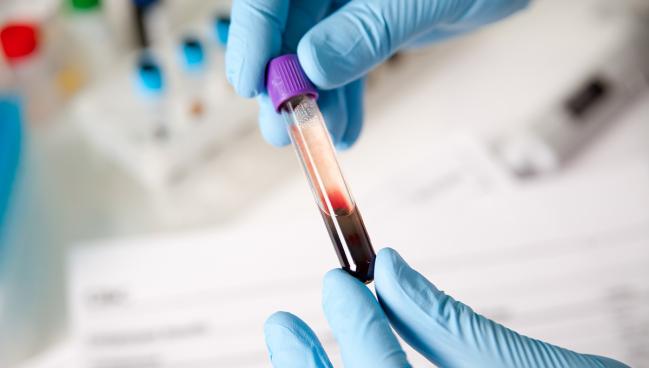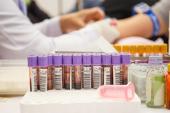Point-of-Care High-Sensitivity Assay for Troponin I Compares Well With Central Labs
While the potential is there, some issues need to be worked out before adding POCs into diagnostic workflow, says Allan Jaffe.

A point-of-care (POC) high-sensitivity assay for cardiac troponin I (hs-cTnI) shows diagnostic accuracy comparable to what’s achieved by central laboratory assays and could potentially be a useful addition to early-triage algorithms for patients who present to emergency departments (EDs) with chest pain, according to an analysis from the APACE study.
The SpinChip assay (SpinChip Diagnostics) showed high agreement across various blood sample types, particularly between measurements taken from whole blood and frozen Li-Heparin plasma, said lead author Luca Koechlin, MD (University Hospital Basel, Switzerland).
“When comparing our data to previously published data on other POC hs-cTnI assays, we found that the efficacy of the POC hs-cTnI SpinChip 0/1-hour algorithm—measured by the number of patients who could be triaged for rule-in and rule-out—was higher than that of other POC hs-cTnI assays,” Koechlin said in an email.
He added that the findings need to be confirmed by further studies comparing the SpinChip algorithm with the other POC hs-cTnI assays that have demonstrated similar abilities and can be embedded in early-triage algorithms. In a prior APACE analysis, researchers found that the TriageTrue POC hs-cTnI assay (Quidel) had high diagnostic accuracy for NSTEMI compared to assays requiring a central lab.
Koechlin said a direct comparison of all POC hs-cTnI assays within the same patient cohort is necessary to evaluate potential differences among them.
“Moreover, further research should investigate whether the use of POC hs-cTn assays in emergency departments, given their shorter turnaround time compared to central laboratory hs-cTn assays, leads to quicker triage and, subsequently, improvements in both medical and economic outcomes,” he added.
While POC assays are likely to eventually facilitate more rapid care in the ED, they still have a ways to go to prove themselves to cardiologists and hospital systems, noted Allan Jaffe, MD (Mayo Clinic, Rochester, MN), who was not involved in the study.
“One thing we know is that if you use the central lab and get a value that just doesn't make sense, we have all kinds of ways to troubleshoot it. We are not yet at the point where we understand [how to do that] with these point-of-care assays,” he noted. “I don’t think it’s unsolvable, but it is a concern.”
The most tested POC assays like SpinChip, TriageTrue, and Atellica VTLi (Siemens) have different antibodies, as well as different analyzing platforms, and essentially don’t correlate one-to-one with each other, Jaffe added.
“In the long run, this is going to be important . . . and so is how you handle having two assays functioning in a hospital—one for point-of-care and one for the central laboratory,” Jaffe said, adding that while he sees the POC assays as a good thing, an argument could be made that having two systems could increase the risk for physician interpretation error.
A recent study found that only about one in three US hospitals are currently using high-sensitivity cardiac troponin assays, although that number appears to be on the rise. In the United States, they are now the preferred standard for a biomarker diagnosis of acute MI, according to the 2021 American College of Cardiology/American Heart Association guidelines for the evaluation and diagnosis of chest pain (class 1, level of evidence of B).
APACE Analysis
For the study, published this week in the Journal of the American College of Cardiology, Koechlin and colleagues compared the POC SpinChip assay with two central laboratory assays for troponin: Architect (Abbott) and Elecsys (Roche). In the 1,155 APACE study participants (mean age 62 years; 38.2% women) presenting to the ED, STEMI was adjudicated in 53 patients and NSTEMI in 214. More than 50% of the group had noncardiac causes of their chest pain.
Concentrations of hs-cTnI were highest in those with STEMI (median 1,418 ng/L), but those with STEMI or NSTEMI had higher concentrations at 0 hours than those with other diagnoses (P < 0.001).
The area under the receiver-operating characteristic curve (AUC) was 0.94 (95% CI 0.92-0.95) for the SpinChip hs-cTnI assay. In comparison, the AUC was 0.94 (95% CI 0.92-0.95) with the Architect hs-cTnI assay (P = 0.907), and 0.93 (95% CI 0.91-0.95) for the Elecsys hs-cTnT assay (P = 0.305) when the same sample was tested in patients without STEMI.
The investigators used a 0/1-hour algorithm for triaging 765 NSTEMI patients into rule-out, observe zone, and rule-in. NSTEMI was ruled out if the hs-cTnI level was < 7 ng/L or < 7 ng/L with a delta at 1 hour of < 4 ng/L (n = 387). These values ruled out 51% with a sensitivity and negative predictive value of 100% (95% CI 97.7%-100%) and 100% (95% CI 99.0%-100%), respectively.
Having [a POC assay] should or could, in the ideal world, allow one to make a more rapid diagnosis, or it might not. Allan Jaffe
NSTEMI was diagnosed if the level was ≥ 36 ng/L or the delta at 1 hour was ≥ 11 ng/L (n = 203). These values ruled in 27% with a specificity and positive predictive value of 90.9% (95% CI 88.3%-92.9%) and 72.9% (95% CI 66.4%-78.6%), respectively.
All other patients (n = 175) were placed in the observe zone.
At 30 days, rates of MACE were 0.8%, 8.1%, and 1.9% in the rule-out, observe, and rule-in groups, respectively, with SpinChip, which was comparable to the triage performance of the two laboratory-based systems.
At a median follow-up of 5 years, the rate of all-cause death for the entire cohort was 12.5%. By triage category, cumulative mortality rates were 5.6% in the rule-out group, 26.8% in the rule-in group, and 14.7% in the observe group (log-rank P < 0.001) with SpinChip. This prognostic performance was comparable to those of the two central laboratory assays.
Potential Benefits Tempered With Cautious Optimism
In an accompanying editorial, Aldo Clerico, MD (Scuola Superiore Sant’Anna, Pisa, Italy), and colleagues note that the SpinChip algorithm’s ability to stratify patients into distinct risk categories for long-term outcomes “highlights its value in guiding clinical decision making beyond the initial diagnosis.”
The editorialists say the high agreement between different sample types seen in the study also points to flexibility and the potential to increase accessibility to high-sensitivity troponin in varied clinical settings, including prehospital care, general practice, and remote locations.
“The introduction of POC hs-cTn assays will broaden the range of medical settings where patients can benefit from hs-cTn testing,” Koechlin told TCTMD. “This includes ambulances, general practitioners, cardiologists in private practice, and satellite emergency departments.”
One issue raised by Clerico and colleagues, however, is cost.
“The International Federation for Clinical Chemistry has recommended that the cost/benefit of the routine use of hs-cTnI POC testing methods in the clinical pathway in emergency/urgency departments and intensive care units must be carefully calculated before implementation in clinical practice,” they write.
Jaffe said while he agrees that the POC assays have great potential, all of these issues and more still need to be ironed out before cardiologists are likely to embrace them without worrying about miscategorizing patients. In particular, he said the rule-in portion of the SpinChip algorithm could allow for a patient to be diagnosed with MI without meeting the Universal Definition of MI.
“Having [a POC assay] should or could, in the ideal world, allow one to make a more rapid diagnosis, or it might not. There have been studies [showing that] making a diagnosis earlier didn’t actually change the way the emergency department works,” he said. Assuming the POCs can be successfully fitted into workflow algorithms and prove reliable, “then you can start with the appropriate reconfiguration to send people home earlier and potentially impact some on the issues of ED overcrowding that impact all patients who are there, not just those with chest pain.”
L.A. McKeown is a Senior Medical Journalist for TCTMD, the Section Editor of CV Team Forum, and Senior Medical…
Read Full BioSources
Koechlin L, Boeddinghaus J, Lopez-Ayala P, et al. Clinical and analytical performance of a novel point-of-care high-sensitivity cardiac troponin I assay. J Am Coll Cardiol. 2024;84:726-740.
Clerico A, Aimo A, Passino C. Point-of-care high-sensitivity troponin testing in the emergency department: the way of the future? J Am Coll Cardiol. 2024;84:741-743.
Disclosures
- The APACE study was supported by research grants from the Swiss National Science Foundation, the Swiss Heart Foundation, the University Hospital Basel, the University of Basel, Abbott, Beckman Coulter, Brahms, Idorsia, LSI Medience Corporation, Ortho Clinical Diagnostics, Quidel, Roche, Siemens, Singulex, and SpinChip Diagnostics.
- Koechlin reports speaker honoraria from Roche Diagnostics, Abbott, Polymedco, and Siemens, all outside of the submitted work and paid to the institution.
- Clerico reports no relevant conflicts of interest.
- Jaffe reports consulting for companies that manufacture troponin assays; and holding stock in RCE Technologies, a manufacturer of a skin-based troponin sensor.






Comments